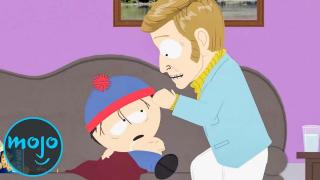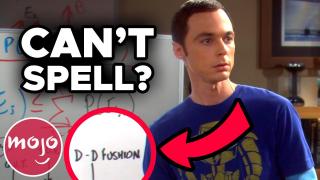Top 10 Science Lessons We Learned from The Big Bang Theory

#10: Archimedes’s Principle “The Toast Derivation”
Sheldon idolizes the greatest minds in history; one name that tends to pop up is Archimedes – yes, the “Eureka!” guy. In one notable example, Sheldon interrupts Zack’s steamy story with an anecdote about the Ancient Greek mathematician. You might recall that tale from your school science class: a gold crown, a bath, density, and some serious brainpower. But according to physics whiz and science advisor on the show, David Saltzberg, a modern-day Archimedes might’ve considered that one could mix gold with denser materials. He also noted that if you bend the laws of physics, you could be sitting on a goldmine. Too bad the others weren’t listening; they could have had their own “Eureka!” moment.
#9: The “Manstruation” Myth “The Wheaton Recurrence”
Top 20 Times The Big Bang Theory Tackled Serious Issues
Let’s clear this up straight off the bat: no, men don’t “manstruate.” But Sheldon’s right; they do have their own hormonal cycle. However, instead of monthly, men’s testosterone levels go up and down throughout the day. It’s supposedly highest in the morning, lowers as the day goes on, and rebuilds during sleep. Just like how the menstruation cycle can affect how someone feels, these rises and dips can affect men’s moods and behaviors, too. But we don’t think that’s what Leonard’s experiencing here; he just dropped an unreciprocated L-bomb; who wouldn’t be devastated!? Still, if they’re going to play on that age-old trope, then doesn’t Leonard also deserve an ice cream treat?
#8: Non-Newtonian Fluid “The Barbarian Sublimation”
Top 20 Hilarious Big Bang Theory Bloopers
In this Season 2 episode, the guys have a blast pouring a mix of cornstarch and water on a speaker and cranking up the tunes. What’s utterly mind-blowing is that, despite starting as a liquid, the mixture springs to life like a solid once the sound vibrations hit it. This matter-bending magic is the work of a non-Newtonian fluid – a substance that defies the rules, switching between solid and liquid states depending on its environment. Apply some force, and it stiffens up; relax the pressure, and it’s a liquid again. There are tons of cool DIY experiments online, and you only need two simple ingredients! Penny might not be impressed, but we sure are.
#7: A Jellyfish’s Life Cycle “The Tenure Turbulence”
Top 10 Times South Park Taught Us Serious Life Lessons
During lunch in the cafeteria, Leonard shares this cool fact: there’s a type of jellyfish, the Turritopsis dohrnii, that’s practically immortal! While regular jellyfish succumb to old age, stress, or injury, these remarkable sea creatures have a fantastic trick up their tentacles. Instead of dying, they shrink, settle on the seabed, and magically turn back time, starting their life cycle all over again. It’s a bit like the mythological Phoenix rising from the ashes. But imagine a superhero with Turritopsis dohrnii superpowers; that would be pretty neat! This fun fact leads the group to contemplate a reality where immorality exists. Honestly, we’re just surprised no one makes a “Doctor Who” joke.
#6: Where Do You Keep Your Bread? “The Cornhusker Vortex”
Top 10 Mistakes That Were Left in The Big Bang Theory
Ever wondered where to store your bread? In a bread box, a sealed container, or perhaps the fridge like Penny? Sheldon tells her that she shouldn’t keep her bread in there as it could cause it to go off faster, and guess what? He’s not wrong. Keeping bread in the fridge makes it go stale quicker! Why? Flour has tiny starch molecules. When baked, they make our bread soft and tasty. But as it cools, these molecules restructure, making the bread hard and less moist, and can compromise the flavor. If you ask us, it’s Penny who should be thanking Sheldon. With his advice, she can enjoy fresher bread and save some extra dough!
#5: Game Theory Various
Top 10 Game of Thrones Fan Theories That Were Wrong
The mathematically inclined among us may have already noticed that Sheldon and Amy’s relationship plays into Game Theory. What’s that, you ask? It’s like playing a game where you plan your moves, think about what others might do, and try to collaborate smoothly. While it might not sound very romantic, it’s about thinking ahead and making predictions without getting into complicated math. Sheldon and Amy often face situations where they have to consider each other’s feelings and make decisions that impact both of them. They (arguably Amy more than Sheldon) try to balance their own desires with what’s best for their relationship. They even find themselves caught in a “Prisoner’s Dilemma” while planning their wedding.
#4: The Properties of Graphene “The Einstein Approximation”
Top 10 The Big Bang Theory Moments That Made Us Happy Cry
In this episode, arguably best known for this scene, Sheldon agonizes over trying to understand why electrons exhibit weightlessness while moving through graphene. Graphene was a hot topic in the physics world in the mid-2000s and early 2010s. But what is it exactly? Well, in 2004, two brilliant minds, Andre Geim, and Konstantin Novoselov, managed to extract an ultra-thin layer of carbon atoms using just a regular pencil and everyday sticky tape. Even though it’s super strong, this material is so thin that you can’t see it with your eyes. However, scientists think it has the potential to change our future by leading to amazing inventions. No wonder Sheldon is so determined to unravel its mysteries!
#3: The Doppler Effect “The Middle-Earth Paradigm”
Top 10 Most Romantic The Big Bang Theory Moments
Remember that hilarious Season 1 Halloween episode where Sheldon dresses up as the Doppler effect? For anyone who missed it or doesn’t remember, the Doppler effect is all about how sound or light changes when an object moves closer or farther away from you. Picture this: when a car zooms past, the engine sounds louder as it nears you and softer as it goes away. Why? Because the sound waves squash together as it gets closer, making it loud, and stretch out as it moves away, making it quiet. Astronomers can also use it to detect shifts in galaxies. We could break it down for you more, but we think Sheldon actually summarizes it best [1].
#2: Magnetic Monopoles “The Monopolar Expedition” & “The Electric Can Opener Fluctuation”
At the end of Season 2, Sheldon and the gang gear up for a journey to the North Pole in search of magnetic monopoles, mysterious magnets that could unlock the secrets of the universe. He believes that could be game-changing for String Theory, but unfortunately, things don’t go quite as planned. But he’s far from the only scientist on this quest. Why are magnetic monopoles so important, you ask? Well, imagine them as rare puzzle pieces that can enhance our understanding of our world. Scientists have scoured for these elusive magnets like hidden treasures, but if they exist, they remain unfound. So, Sheldon shouldn’t be disheartened; he’s not the sole explorer who’s come back empty-handed. Before we unveil our top pick, here are a few honorable mentions. Amy Farrah Fowler’s Real Brain Power, “Various” Like Amy, Actor Mayim Bialik Has a PhD in Neuroscience, so She Really Knows Her Stuff! GloFish, “The Luminous Fish Effect” Do You Think Sheldon Got His Inspiration Here? Neil deGrasse Tyson Eclipses Pluto, “The Apology Insufficiency” The Astrophysicist Called Himself an “Accessory” to the Demotion of Pluto, so Sheldon’s Fury Is Totally on Point! Penguins & Monogamy, “The Hofstadter Insufficiency” Raj Sure Knows a Lot About Penguin Relationships; The Highs & the Lows
#1: Schrödinger’s Cat Various
“The Big Bang Theory” made science accessible and engaging, especially for those of us who might have forgotten our school lessons. If our teachers had applied scientific theories to everyday problems like Sheldon does for Penny, maybe we would’ve remembered more from those classes. But hey, for anyone who’s here for the science but isn’t much of a “BBT” fan, we’ll let Sheldon catch you up. Sure, Schrödinger’s cat is used to help scientists unravel the mysteries of quantum mechanics, but as Sheldon teaches us, it can have real-world applications, too. So naturally, the gang calls back to it on several occasions. Not only do we get a science lesson, but that’s some great life advice, too! Did anything you learned from “The Big Bang Theory” help you in the real world? Show us your workings in the comments.








